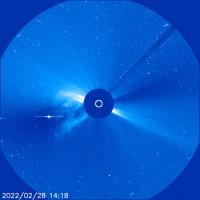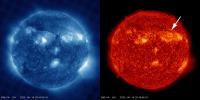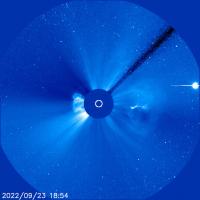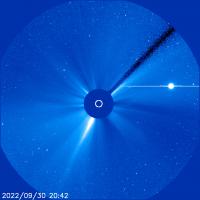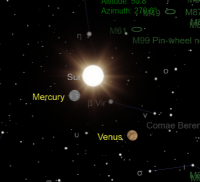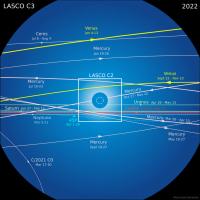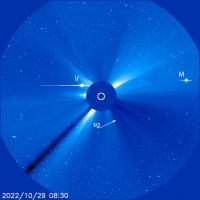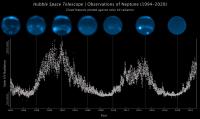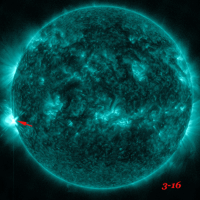Printable Version of Topic
Click here to view this topic in its original format
Unmanned Spaceflight.com _ Sun _ Solar Cycle 25
Posted by: titanicrivers Feb 17 2022, 09:05 PM
As many UMSF members have likely noticed the current Solar Cycle (25) is off with a bang! https://en.wikipedia.org/wiki/Solar_cycle_25#/media/File:Solar_Cycle_25_prediction_and_progression.png. SOHO observations https://soho.nascom.nasa.gov/spaceweather/ coupled with daily comments in Space Weather https://spaceweather.com/ provide an excellent way to follow this activity.
Posted by: jastus Feb 17 2022, 09:21 PM
The ionosphere is certainly starting to show a strong response to the new cycle - see https://spawx.nwra.com/spawx/ssne-year.html.
Posted by: Xerxes Feb 18 2022, 02:49 PM
These are good suggested websites; I would add to them:
- https://www.spaceweatherlive.com/en.html, which has deeper archives, in case you miss a big event and want to go back
- https://www.swpc.noaa.gov/communities/space-weather-enthusiasts, which summarizes a large number of different views and predictions on a single page
- https://www.swpc.noaa.gov/products/wsa-enlil-solar-wind-prediction for tracking CMEs and potential future auroral events
- https://sdo.gsfc.nasa.gov/data/dashboard/ for the latest movies of the solar surface
Posted by: stevesliva Feb 19 2022, 03:37 AM
The MAVEN presentation at the MEPAG addressed how it is measuring atmospheric escape at Mars as the solar cycle ramps up. It says it may be constraining this better for Mars than for Earth.
https://mepag.jpl.nasa.gov/meeting/2022-01/08_Curry_MEPAG_maven_2022_01.pdf
In other news, SpaceX/Starlink lost 40 satellites between Feb 3 and Feb 8 before they could move out of their deployment orbit... because a solar event puffed up the atmosphere. Crazy.
Posted by: titanicrivers Feb 19 2022, 07:35 PM
As Solar Cycle 25 activities increase, CME’s directed at Earth are more likely. In fact, the site of a large solar CME on Feb 17th https://spaceweatherarchive.com/2022/02/19/huge-explosion-on-the-farside-of-the-sun/ is expected to rotate into view over next few days. This area may be sunspot AR2936 who’s activity likely was responsible for the Starlink satellite incident https://spaceweatherarchive.com/2022/02/09/the-starlink-incident/ mentioned by stevesliva in the previous post. It would be interesting if one could monitor proton flux data (see Juramike’s awesome method described here http://www.unmannedspaceflight.com/index.php?showtopic=6715) using upcoming SOHO movie images of the sun.
Posted by: fredk Feb 19 2022, 09:39 PM
Isn't there some L1 proton flux data available from ACE or DSCOVR? See, for example https://www.swpc.noaa.gov/products/ace-real-time-solar-wind
Posted by: titanicrivers Feb 20 2022, 07:15 PM
As fredk mentions above there are other satellites orbiting the sun at Lagrange 1 point (L1) including the Advanced Composition Explorer (ACE) satellite https://www.swpc.noaa.gov/products/ace-real-time-solar-wind and the DSCOVR (Deep Space Climate Observatory) https://www.ngdc.noaa.gov/dscovr/portal/#/ satellite besides SOHO (Solar and Heliospheric Observatory) https://space.umd.edu/pm/ that monitor energetic properties of the solar wind in near real time and provide data portals that plot proton flux density and solar wind velocity. These are great resources to follow the sun’s activity.
Juramike’s method http://www.unmannedspaceflight.com/index.php?showtopic=6715) is certainly more hands on and fun and comparisons with the spacecraft data might be illuminating and satisfying!
Posted by: titanicrivers Feb 28 2022, 09:45 PM
An interesting aspect of spacecraft monitoring the sun are the real-time videos from SOHO (C3 camera) for example. A possible coronal mass ejection today, (with Jupiter approaching solar conjunction in the background) is shown below.
Posted by: titanicrivers Mar 1 2022, 09:17 PM
Some interesting predictions and possible mechanisms concerning the strength of Solar Cycle 25 are highlighted in Spaceweather https://spaceweatherarchive.com/2022/02/25/the-termination-event-has-arrived/ today. A link to a paper published in 2020 concerning the effect of overlapping solar magnetic activity cycles and sunspot number is here: https://link.springer.com/article/10.1007/s11207-020-01723-y/
Posted by: titanicrivers Mar 25 2022, 08:25 PM
Additional information that Solar Cycle 25 is intensifying is provided by data from NASA’s TIMED spacecraft https://www.nasa.gov/centers/goddard/pdf/110905main_FS-2001-09-026-GSFC-TIMED.pdf and summarized in some detail here https://spaceweather.com/ .
Posted by: Sean Mar 26 2022, 04:25 AM
This is ångström 171, 193 & 211 data from Solar Dynamics Observatory, on March 23rd & 24th, 2022.
14,522 frames were repaired, graded, blended & rescaled to create the footage.
Here it is on https://youtu.be/O4BP-NuifcU
Samples...

Posted by: Floyd Mar 26 2022, 02:53 PM
Thanks Sean, that was really enjoyable to watch!!!
Posted by: titanicrivers Apr 5 2022, 06:22 PM
The Space Weather Prediction Center in conjunction with NOAA has an informative interactive data plot of Solar Cycle 25's observed increased activity versus the predicted official forecast https://www.swpc.noaa.gov/products/solar-cycle-progression.
Posted by: Sean May 1 2022, 06:13 PM
102,018 graded frames of ångström 171, 193 & 211 for 14 days from April 09, 2022 by Solar Dynamics Observatory
Trailer on https://twitter.com/_TheSeaning/status/1520749239634214914
45m45s 4k on https://youtu.be/KWQ3EKvRcvg
Posted by: titanicrivers May 12 2022, 07:40 PM
Most recent summary (April data) from https://www.swpc.noaa.gov/products/solar-cycle-progression and recent CMEs https://spaceweather.com/ (fortunately not headed at Earth) remind us (as did Mongo’s posts here in 2014 http://www.unmannedspaceflight.com/index.php?showtopic=7843 and this link https://science.nasa.gov/science-news/science-at-nasa/2014/23jul_superstorm/ of consequences related to our Sun’s increasing activity. While Earth has multiple sun-montoring satellites to tell us of oncoming solar storm events we mainly have Earth’s magnetic fields to mitigate the effects of those storms.
Posted by: titanicrivers May 13 2022, 09:52 PM
The first “sunquake” http://soi.stanford.edu/press/agu05-98/press-rel.html of Solar cycle 25 was recorded by the SDO on May 10th 2022 as summarized in today’s (5-13-2022) SpaceWeather page https://spaceweather.com/. Some possible mechanisms underpinning “sunquake” observations are addressed here https://iopscience.iop.org/article/10.3847/2041-8213/abad2a .
Posted by: titanicrivers May 19 2022, 06:18 PM
An amazing SDO video https://sdo.gsfc.nasa.gov/data/latest48.php?q=0304 from today https://spaceweather.com/images2022/19may22/geyser_anim_crop.gif
Posted by: titanicrivers Jun 4 2022, 05:09 PM
Some interesting data plots concerning solar cycle 25 as well as historical data and future predictions of solar activity based on sunspot numbers and interplanetary coronal mass ejections (ICMEs) https://helioforecast.space/solarcycle . Data is provided by the Helio4Cast group whose informative home webpage is here https://helioforecast.space/
Posted by: titanicrivers Jun 20 2022, 01:09 AM
Today’s SDO spacecraft images feature a “Man in the Sun” (below, left)! The “eyebrow” area of the left eye (arrow on right) is an amazing magnetic filament that stretches 370,000 km from end to end. One end of the filament is attached to sunspot AR3032. A video of plasma flow along the filament is presented here https://spaceweather.com/images2022/18jun22/filament_anim_crop.gif.
Posted by: titanicrivers Jun 24 2022, 08:46 PM
A quote from SpaceWeather.com
“WANTED: WHITE LIGHT IMAGES OF THE SUN: A wildfire in California has cut off electricity to Stanford University, home of the Solar Dynamics Observatory (SDO) data center. As a result, we are not receiving images from SDO. You can help! Readers are encouraged to submit their own full-disk white light images of the sun so we can see what the sun looks like today. Submit your images here.” https://spaceweathergallery.com/submissions/index.php
No doubt a number of UMSF members are aware and can contribute!
Posted by: titanicrivers Jun 28 2022, 04:26 PM
SDO data center is back in operation today.
Posted by: titanicrivers Jul 26 2022, 09:55 PM
While atmospheric balloons are not exactly unmanned spacecraft, data from Earth to Sky Calculus https://www.facebook.com/earthtoskycalculus uses balloons to measure deep space-atmospheric cosmic rays which are inversely proportional to solar activity. As solar activity of cycle 25 continues to increase measurements of cosmic rays from deep space decreases.
Posted by: titanicrivers Aug 15 2022, 05:56 PM
SOHO and SDO continue to document increased solar cycle 25 activity. SpaceWeather’s page from today https://spaceweather.com/ nicely summarizes the activity of two current sunspots, AR 3076 and AR 3078. AR 3076 in the sun’s northern hemisphere exhibits ‘reverse polarity’ increasing it’s potential to explode https://agupubs.onlinelibrary.wiley.com/doi/full/10.1029/2018JA025935 due to a magnetic reconnection event.
Posted by: titanicrivers Aug 31 2022, 09:01 PM
Today’s interplanetary coronal mass ejection (ICME) is directed at Venus https://spaceweather.com/. While we Earthlings are safe there seems to be some uncertainty as to whether Venus will experience some increased atmospheric loss.(not that Venus will notice!). The effects of an ICME on an unmagnetized planet such as Mars and Venus are comparatively poorly understood. https://agupubs.onlinelibrary.wiley.com/doi/full/10.1002/2014JA020616
Posted by: titanicrivers Sep 5 2022, 10:45 PM
The CME directed at Venus (post above) arrived on September 2nd. This was 2 days before the Venus flyby of ESA’s Solar Orbiter probe https://www.esa.int/Enabling_Support/Operations/Coronal_mass_ejection_hits_Solar_Orbiter_before_Venus_flyby . Fortunately the probe was designed to survive and measure such outbursts and today appeared to have completed a successful flyby.
Posted by: titanicrivers Sep 24 2022, 06:39 PM
Multiple CME’s and Mercury appear in LASCO’s C3 fov on 9-23.
Posted by: bkellysky Oct 1 2022, 01:17 AM
Now Venus is in the C3 view. Mercury will rejoin Venus late in October. They'll exit the view together in late November.
bob
bob
Posted by: titanicrivers Oct 2 2022, 06:18 PM
Whoops! Thanks for the correction bkellysky!
Posted by: bkellysky Oct 2 2022, 09:04 PM
Weird thing is I thought I was going to correct you, but on the date of the C3 view, the map of transits across the C3 view didn't have Venus there yet (or just barely) and Mercury was in the view. So, I just added a later C3 photo that I knew had Venus. I hope I haven't confused this totally!
bob
Posted by: titanicrivers Oct 4 2022, 03:10 AM
Using Stellarium to help identify the C3 SOHO background stars it is clear that VENUS (with Eta Virginis nearby) is the planet in C3’s field of view.
Posted by: bkellysky Oct 5 2022, 01:44 PM
Thanks!
Posted by: titanicrivers Oct 31 2022, 12:05 AM
Venus (V) and now Mercury (M) appear in SOHO C3 fov of 10-29-202. A possible, tiny sungrazer comet (sg) also is seen in image below.
Posted by: titanicrivers Dec 13 2022, 07:35 PM
A new paper describing the solar cycles of sunspot and surface magnetic field activity and observations of the Wilcox Solar Observatory using data from space observations of SOHO/MDI and SDO/HMI is presented here. https://www.frontiersin.org/articles/10.3389/fspas.2022.923049/full
Posted by: titanicrivers Dec 31 2022, 07:59 PM
Some year end data concerning Solar Cycle 25! Solar activity continues to exceed prediction levels https://www.swpc.noaa.gov/products/solar-cycle-progression. Multiple observations including the decline in neutron counts reaching earth https://cosmicrays.oulu.fi/ are supportive. The latter suggests lower energy galactic cosmic rays are being downward modulated by enhanced solar activity including effects of CME’s reaching Earth.
Posted by: titanicrivers Feb 2 2023, 10:07 PM
Latest sun spot data for Jan 2023 available here: https://www.swpc.noaa.gov/products/solar-cycle-progression. Also see comet 96P Machholz swing around the sun in the SOHO C3 fov. https://spaceweather.com/images2023/29jan23/lasco_comet_anim6.gif. Apparently some new observations on this unique comet during this pass are pending.
Posted by: titanicrivers Mar 4 2023, 05:11 PM
Sunspot number and solar flux data for February continue to support a lively Solar Cycle 25 https://www.swpc.noaa.gov/products/solar-cycle-progression
Posted by: titanicrivers Apr 12 2023, 10:52 PM
This is a link https://www.frontiersin.org/articles/10.3389/fspas.2023.1050523/full to a compilation of 6 papers describing previous solar cycle observations and resulting predictions concerning Solar Cycle (SC) 25. Most recent observations continue to suggest CS25 will be much more energetic than predicted and that the peak of activity will be earlier (late 2023-mid 2024) than initially forecast.
Posted by: titanicrivers May 14 2023, 01:08 AM
An interesting paper and experiment, https://www.mdpi.com/2075-1729/13/5/1103 was discussed in today's SpaceWeatherNews page. https://spaceweather.com/ . The experiment compares the production of amino acids in a simulated paleo Earth atmosphere by irradiation by a beam of high energy protons compared to spark discharges produced using a Tesla coil, a proxy for lightning, (the latter a variation on the famous Miller-Urey experiment of 1952). High energy protons produced by superflares (SEPs) were common in the young Sun's history, hence the proxy of a proton beam. Results showed the production of amino acids to be orders of magnitude greater using proton beam irradiation compared to spark discharges. The full paper is available in the first link above.
Posted by: titanicrivers May 29 2023, 08:18 PM
There's a new ground-based, solar telescope in it's Operations Commissioning Phase, The U.S. National Science Foundation’s (NSF’s) Daniel K. Inouye Solar Telescope. The telescope's description and a bevy of early images can be found here: https://nso.edu/press-release/new-images-released-by-nsfs-inouye-solar-telescope/
Posted by: titanicrivers Jun 3 2023, 05:47 PM
A warning to LEO satellites … the Thermosphere has heated up and risen to the highest altitude level in 20 years thanks to the energetic geomagnetic storms and solar flares of Solar Cycle 25, according to measurements from the SABER (Sounding of the Atmosphere using Broadband Emission Radiometry) instrument on the TIMED (Thermosphere, Ionosphere, Mesosphere, Energetics and Dynamics) spacecraft and Martin Mlynczak of NASA’s Langley Research Center. An excellent description of the instrument and satellite and the index used to monitor the Thermosphere can be found here https://spaceweatherarchive.com/2022/03/23/what-is-tci/ and here https://spaceweather.com/
Posted by: titanicrivers Jul 3 2023, 10:50 PM
June NOAA Solar Cycle Progression data continues to support a strong Cycle 25. Plotted data is presented here: https://www.swpc.noaa.gov/products/solar-cycle-progression
Posted by: titanicrivers Aug 11 2023, 08:06 PM
Data from NOAA Solar Cycle Progression continues to support a strong Cycle 25. https://www.swpc.noaa.gov/products/solar-cycle-progression.
Posted by: titanicrivers Aug 24 2023, 03:37 PM
OK, here's a figure from this paper https://www.sciencedirect.com/science/article/abs/pii/S0019103523002440?via%3Dihub showing a correlation between storms and clouds on Neptune and the solar cycles. The solar minimum in 2020 is especially noted for the lack of clouds on Neptune.
Posted by: titanicrivers Aug 24 2023, 04:56 PM
Additional observations using ground based telescopes is presented in this link https://w.astro.berkeley.edu/~imke/Infrared/NeptuneAo/Neptune2023.htm.
Posted by: titanicrivers Oct 8 2023, 08:51 PM
Two items on the SpaceWeather page of (Oct 6 2023) https://spaceweather.com/archive.php?view=1&day=06&month=10&year=2023 are of interest concerning Solar Cycle 25. The magnetic poles of the Sun are rapidly disappearing based on measurements from the Solar Dynamic Observatory and may reverse before the year’s end. Magnetic flux from active regions of the Sun in 2022 and 2023 are weakening the Sun’s N and S polar field strength rapidly. Solar polar field reversals tend to occur at time of Solar Cycle maxima, suggesting an earlier than expected Cycle 25 peak.
Large farside sunspots continue to be observed by NASA's Mars Perseverance rover which images the sun daily to check the air for dust. https://spaceweather.com/images2023/06oct23/todaysimage.jpg shows the farside of the sunspots.
Posted by: titanicrivers Oct 22 2023, 09:02 PM
Solar cycle 25 currently is experiencing a lull in sunspot activity but is likely not at it’s peak (now forecast for 2024-2025). https://www.swpc.noaa.gov/products/solar-cycle-progression. The sunspot lull is usually a temporary fluctuation occurring commonly even in strong solar cycles. https://www.swpc.noaa.gov/news/low-solar-activity-likely-20-22-oct.
Posted by: titanicrivers Dec 11 2023, 06:31 PM
Large sunspots spotted by Mars Perseverance rover https://spaceweather.com/images2023/11dec23/frommars.jpg today. A small comet approaching the sun on yesterday's and today's SOHO C3 video images. https://soho.nascom.nasa.gov/data/Theater/ is cool too!
Posted by: titanicrivers Dec 12 2023, 08:31 PM
Another view of the Kreutz sungrazer comet from yesterday was captured by the Cactus software which autonomously detects CMEs in image sequences from the LASCO instrument on board SOHO. https://www.spaceweatherlive.com/en/solar-activity/latest-cmes.html#45-3
Edit: Scroll down to 2023/12/11 -21:12 after clicking above link.
Posted by: titanicrivers Dec 14 2023, 07:56 PM
Today, enlarging and complex sunspot 3514 produced the most powerful solar eruption, (a strong X2.8-class solar flare) of Solar Cycle 25. NASA's Solar Dynamics Observatory recorded the extreme ultraviolet flash https://spaceweather.com/images2023/14dec23/x3_teal_anim2.gif
Posted by: titanicrivers Jan 23 2024, 08:03 PM
An interesting ‘sympathetic solar flare’ https://spaceweather.com/images2024/23jan24/doubleflare.gif (a pair of flares that occur almost simultaneously in different active regions, not by chance, but because of some physical connection) was recorded by the Solar Dynamic Observatory today (1-23-2024).
The flares erupted from two active sunspot groups (AR3559 and AR3561) shown here: https://spaceweather.com/images2024/23jan24/hmi1898.gif
Two papers explaining characteristics of sympathetic solar flares and their relationship to sunspot numbers and solar cycle strength are found here: https://iopscience.iop.org/article/10.1086/340945/pdf and here: https://link.springer.com/article/10.1007/s10509-022-04145-3
Posted by: titanicrivers Jan 29 2024, 10:57 PM
It is raining protons! While not as massive as the barrage mentioned by Juramike early in this topic http://www.unmannedspaceflight.com/index.php?showtopic=6715), we are currently in the midst of a solar proton ‘storm’ https://spaceweather.com/images2024/29jan24/halocmeSOHO.gif courtesy of an eruption (flare) of a departing sunspot group AR3559 . Protons accelerated by the flare are now following the ‘Parker Spiral’ toward Earth and raining down on our atmosphere. The ‘Parker Spiral’ solar magnetic field effect is demonstrated here https://spaceweather.com/repeat_images/parkerspiral2.png.
Posted by: titanicrivers Feb 24 2024, 07:27 PM
Large sunspot AR3590 currently facing earth has produced multiple X class solar flares over the last few days, including the strongest (X6.3) flare of solar cycle 25 (see link below). As per SpaceWeather today https://spaceweather.com/ this was not responsible for the 12-hour outage of AT&T's network on Thursday 2/22/2024. https://www.swpc.noaa.gov/products/goes-x-ray-flux
Posted by: titanicrivers Mar 9 2024, 05:42 PM
The latest data for Solar Cycle 25 regarding sunspot number and F10.7cm radio flux progressions are found here: https://www.swpc.noaa.gov/products/solar-cycle-progression. Both data plots continue to show a strong cycle with the radio flux data especially exceeding prediction values.
Posted by: titanicrivers Mar 16 2024, 08:20 PM
Solar flare activity associated with sunspot AR 3599, has produced an earth polar cap absorption event
https://www.windows2universe.org/spaceweather/polar_com.html.
Another region of the sun is producing M class solar flares https://spaceweather.com/images2024/16mar24/m4_teal_anim.gif , the origin of which is not quite visible as yet (but is rotating into view over the next 2 days).
Posted by: titanicrivers Mar 18 2024, 04:31 PM
The new active sunspot group, associated with the M class X-ray flares noted in post above, has rotated into view. (See animated gif below). Images are from the Solar Dynamics Observatory https://sdo.gsfc.nasa.gov/mission/
Posted by: titanicrivers Mar 23 2024, 08:39 PM
A ‘sympathetic’ https://iopscience.iop.org/article/10.1086/340945/pdf, X1.12 class, solar flare was recorded today by Nasa’s Solar Dynamic Observatory. https://spaceweather.com/images2024/23mar24/doubleflare_teal.gif. Two sunspots AR3614 and AR3615 appear to be involved. The flare has produced a halo CME https://spaceweather.com/images2024/23mar24/halocme.gif which is Earth directed. A good description of the events appear here https://www.spaceweatherlive.com/en/news/view/526/20240323-x1-1-solar-flare-with-earth-directed-cme.html as well as in today’s SpaceWeather page. https://spaceweather.com/. A moderate geomagnetic storm is predicted. https://www.swpc.noaa.gov/news/geomagnetic-storm-watches-issued-24-25-march-2024.
Powered by Invision Power Board (http://www.invisionboard.com)
© Invision Power Services (http://www.invisionpower.com)

